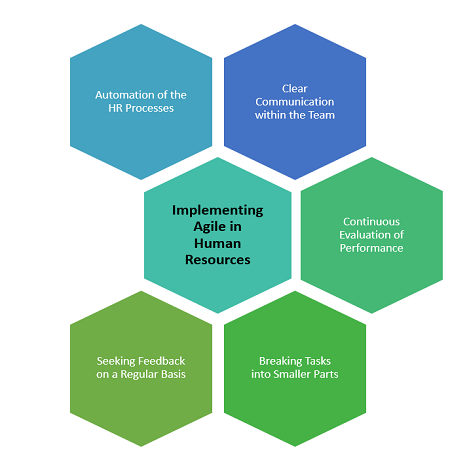Building an Agile Framework for Human Resources

Agile is one of the disruptive technologies that have redefined our approach towards software development and testing. Agile is the most widely used software development framework, and was the result of a brainstorming session between 17 software developer who wanted to come up with a different framework for software development that was faster than the traditional frameworks, and at the same time, was flexible and did not require heavy documentation. While Agile as we know it today is not exactly the same as what the 17 gentlemen had come up on that day, the essence of faster software development and the focus on constant feedback, still holds true.
However, considering that Agile is no more than another software development framework, would not do justice to it. This is simply because Agile is more than just another framework, as it’s a set of principles that apply not for successful software development alone, but to areas of business operations as well. After all, Agile demands the team to work in collaboration and focuses on incremental techniques to create great results. This blog takes a look at how an Agile framework can benefit the Human Resources.
Applying the Principles of Agile to HR

2] Clear Communication among the Team Members
Agile encourages, or rather demands, collaborative team performance for success, and clear communication is one of the pillars of collaboration in a team. No team can work together in the absence of clear communication. Hence, HR professionals should make an effort to encourage and implement clear communication within the team. This ensures everyone is on the same page when it comes to tasks, which in turn helps in faster task completion.
3] Continuous Evaluation of Performance
Continuous testing is one of the key principles of Agile in the domain of software testing, and it translates to continuous evaluation of the performance of the team. When your HR team adopts continuous evaluation, it will result in identification of issues and flaws in time, and will ensure maximum productivity and efficiency. Digital HRMS generates detailed graphical reports for performance assessment.
4] Breaking Tasks into Smaller Parts
Agile approach is all about breaking big tasks into smaller parts and delegating them to resources. Also, there’s the additional requirement of conducting daily meetings to ensure all the tasks are on track and there are no issues or bottlenecks that need to be fixed. If there’s something that doesn’t look right, Agile tells you to find solutions to make it better. In other words, it’s all about continuous improvement.
5] Seeking Feedback on Regular Basis
For Agile testing teams, feedback means speaking to the client, but when it comes to the human resources department, the feedback comes from the employees. This is another step towards implementing continuous improvement and so, is essential if you’re looking forward to implementing Agile to improve the performance fo the HR department.
Conclusion:
So, you see that implementing an Agile framework for the human resources department does not demand too much effort, but has the potential to bring great results. And why not? Agile has proved to be a breakthrough success in the world of software development, and we believe its essence can benefit an organizations and its departments. Have you ever thought of implementing Agile in various departments of an organization? Share your thoughts in the Comment box below.
However, considering that Agile is no more than another software development framework, would not do justice to it. This is simply because Agile is more than just another framework, as it’s a set of principles that apply not for successful software development alone, but to areas of business operations as well. After all, Agile demands the team to work in collaboration and focuses on incremental techniques to create great results. This blog takes a look at how an Agile framework can benefit the Human Resources.
Applying the Principles of Agile to HR
When you want to apply the principles of Agile to the Human Resource Department, the following are some ways to start with.

1] Automation of the HR Processes
Automation is one of the essential pillars of Agile and they go hand in hand. After all, software testing has witnesses a magical transformation with the implementation of Agile principles and automation has been at the heart of this transformation. When you have a software that automates the everyday HR functions, the HR professionals have time left to brainstorm on strategic plans of the department. A new age HRMS software like Digital HRMS is designed to automate every HR task and allows the HR department to pick and choose the modules they want, as per their requirements.2] Clear Communication among the Team Members
Agile encourages, or rather demands, collaborative team performance for success, and clear communication is one of the pillars of collaboration in a team. No team can work together in the absence of clear communication. Hence, HR professionals should make an effort to encourage and implement clear communication within the team. This ensures everyone is on the same page when it comes to tasks, which in turn helps in faster task completion.
3] Continuous Evaluation of Performance
Continuous testing is one of the key principles of Agile in the domain of software testing, and it translates to continuous evaluation of the performance of the team. When your HR team adopts continuous evaluation, it will result in identification of issues and flaws in time, and will ensure maximum productivity and efficiency. Digital HRMS generates detailed graphical reports for performance assessment.
4] Breaking Tasks into Smaller Parts
Agile approach is all about breaking big tasks into smaller parts and delegating them to resources. Also, there’s the additional requirement of conducting daily meetings to ensure all the tasks are on track and there are no issues or bottlenecks that need to be fixed. If there’s something that doesn’t look right, Agile tells you to find solutions to make it better. In other words, it’s all about continuous improvement.
5] Seeking Feedback on Regular Basis
For Agile testing teams, feedback means speaking to the client, but when it comes to the human resources department, the feedback comes from the employees. This is another step towards implementing continuous improvement and so, is essential if you’re looking forward to implementing Agile to improve the performance fo the HR department.
Conclusion:
So, you see that implementing an Agile framework for the human resources department does not demand too much effort, but has the potential to bring great results. And why not? Agile has proved to be a breakthrough success in the world of software development, and we believe its essence can benefit an organizations and its departments. Have you ever thought of implementing Agile in various departments of an organization? Share your thoughts in the Comment box below.
